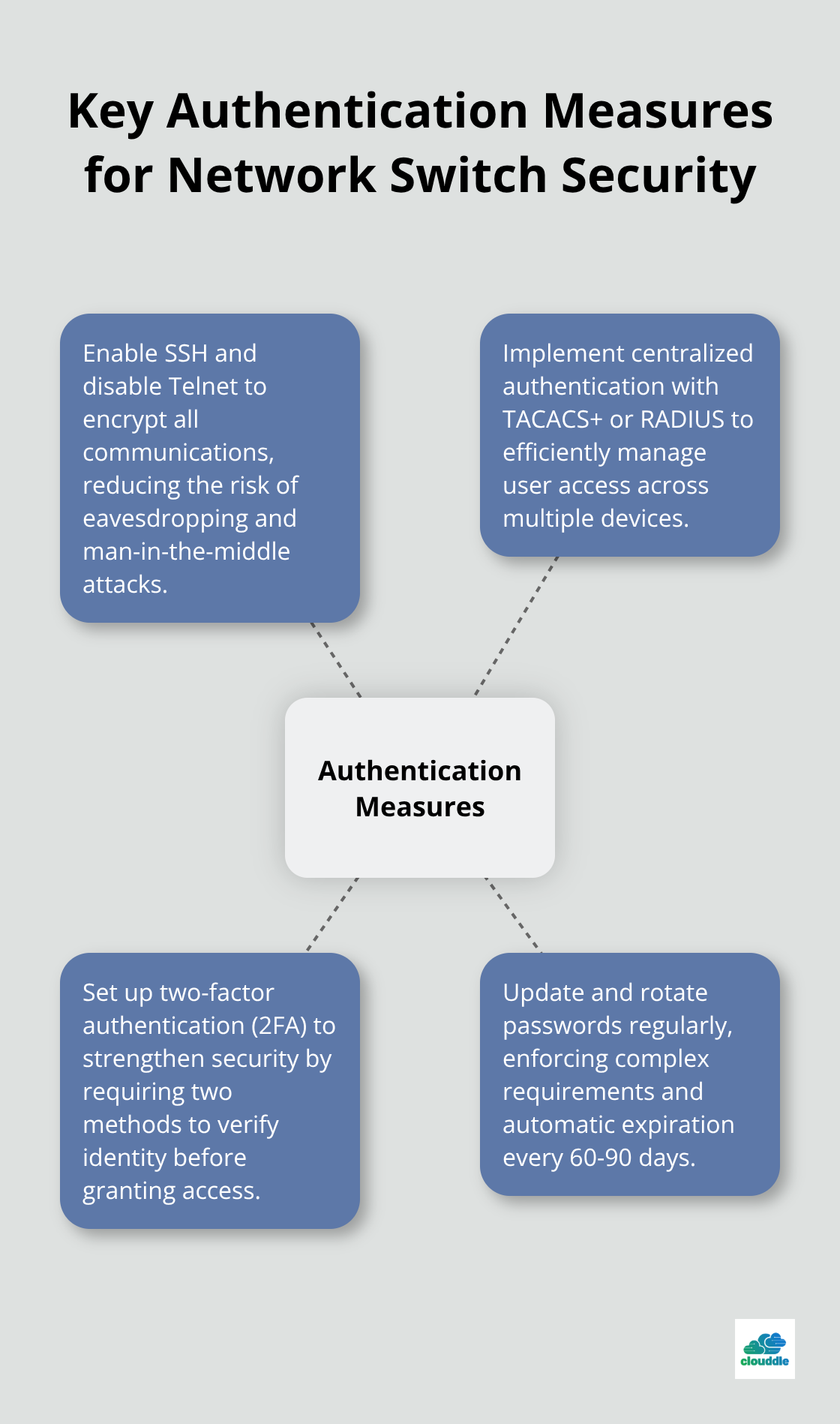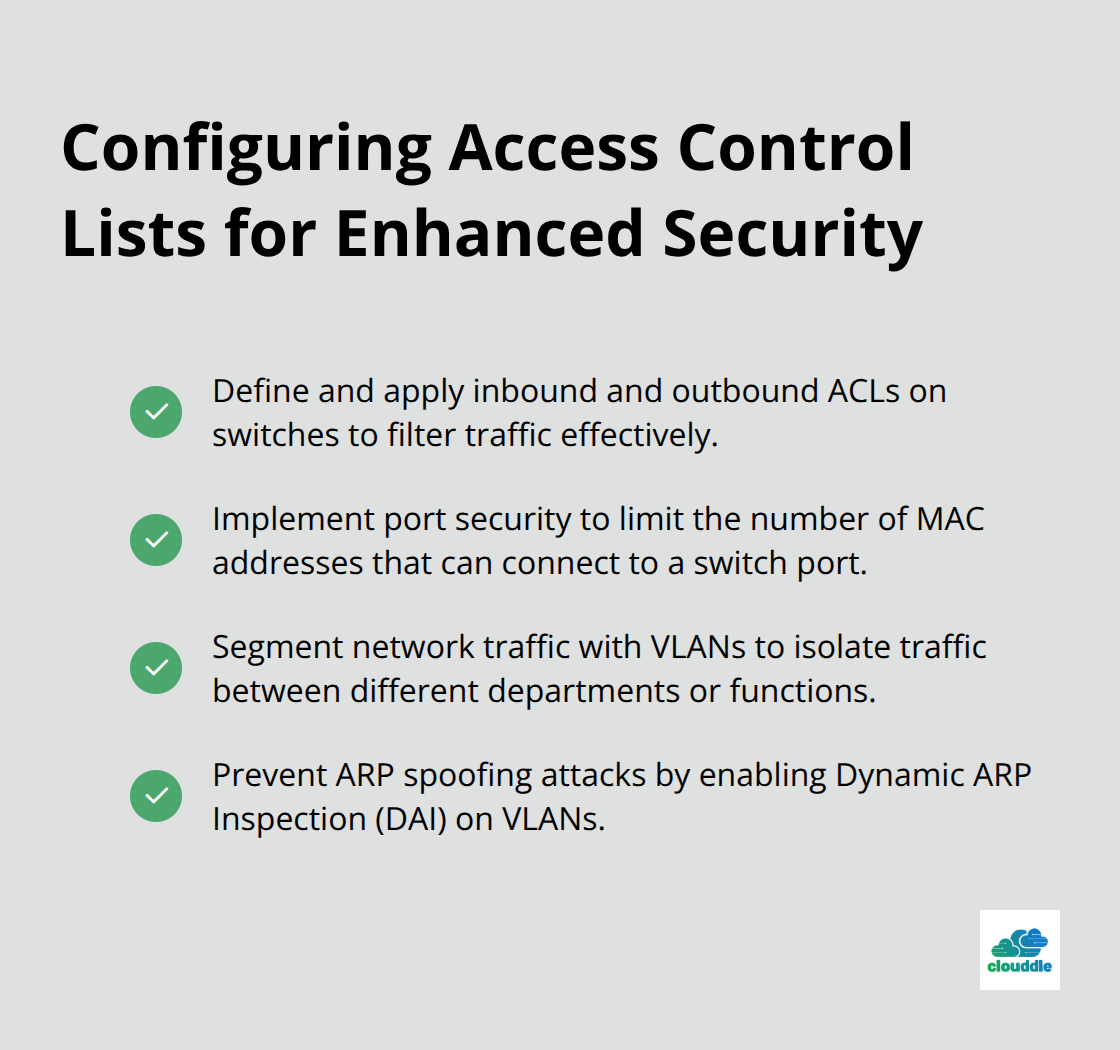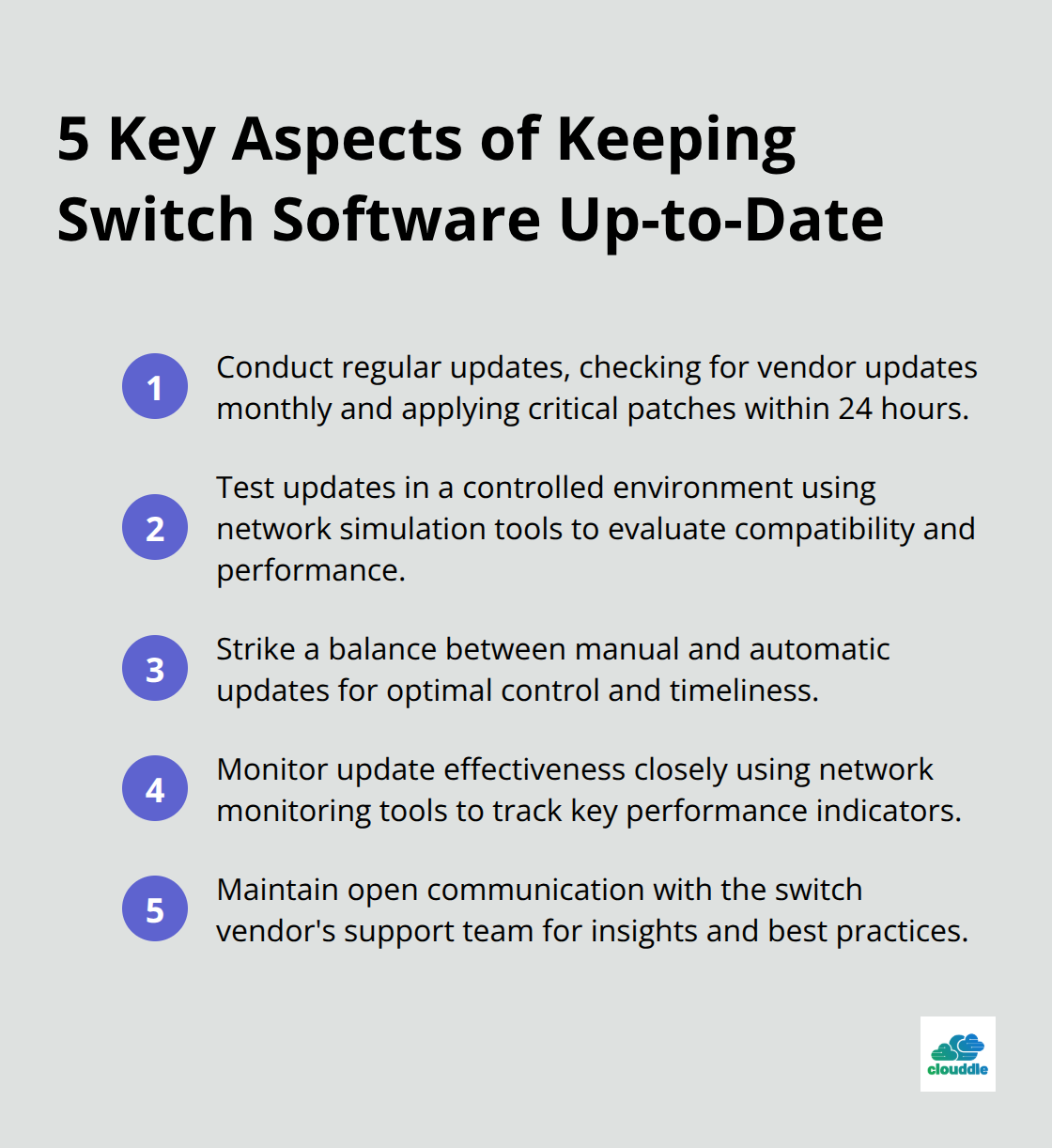Network switch security is a critical aspect of maintaining a robust and protected IT infrastructure. At Clouddle, we’ve seen firsthand how vulnerable networks can be when switches are left unsecured.
This blog post will guide you through practical steps to enhance your network switch security, covering authentication measures, access control, and software updates. By implementing these strategies, you’ll significantly reduce the risk of unauthorized access and potential breaches in your network environment.
Strengthening Authentication: Your First Line of Defense
Network switch security starts with robust authentication measures. Let’s explore practical steps to fortify your network’s first line of defense.
Enable SSH and Disable Telnet
The first step to enhance authentication is to enable Secure Shell (SSH) and disable Telnet on all your network switches. Telnet transmits data in plain text, making it vulnerable to attacks. SSH encrypts all communications, which significantly reduces the risk of eavesdropping and man-in-the-middle attacks.
To enable SSH, access your switch’s command-line interface and use these commands:
switch(config)# ip ssh version 2switch(config)# crypto key generate rsa
Then, disable Telnet with:
switch(config-line)# transport input ssh
Centralize Authentication with TACACS+ or RADIUS
Implement a centralized authentication system like TACACS+ (Terminal Access Controller Access-Control System Plus) or RADIUS (Remote Authentication Dial-In User Service) to manage user access across multiple devices efficiently.
TACACS+ distinctly manages authentication, authorization, and accounting, while RADIUS excels in authentication and accounting. To configure TACACS+ on your switch, use:
switch(config)# aaa new-modelswitch(config)# tacacs-server host 192.168.1.100 key YourSecretKeyswitch(config)# aaa authentication login default group tacacs+ local
Set Up Two-Factor Authentication
Two-factor authentication (2FA) strengthens security by requiring two methods to verify your identity before granting access. Many enterprise-grade switches now support 2FA through various methods (including hardware tokens, software tokens, or SMS-based codes).
For example, if you use a Cisco switch with Duo Security integration, you can set up 2FA with these commands:
switch(config)# aaa new-modelswitch(config)# aaa authentication login default group radius localswitch(config)# radius-server host 1.2.3.4 auth-port 1812 acct-port 1813 key YourRadiusKey
Update and Rotate Passwords Regularly
Establish a strict policy for regular password updates and rotation.
Implement these best practices:
- Enforce complex password requirements (minimum length, special characters, etc.)
- Set up automatic password expiration every 60-90 days
- Use a password manager to generate and store unique passwords for each device
- Avoid default or easily guessable passwords

These authentication measures will significantly enhance your network switch security. However, authentication is just the first step in a comprehensive security strategy. The next section will focus on configuring Access Control Lists (ACLs) to further strengthen your network infrastructure.
How to Configure Access Control Lists for Enhanced Security
Access Control Lists (ACLs) are powerful tools for managing network traffic and enhancing security. We’ll explore practical steps to implement ACLs across various network environments, which can significantly improve network protection.

Define and Apply ACLs
Create inbound and outbound ACLs on your switches. Inbound ACLs filter traffic before it enters the switch, while outbound ACLs filter traffic as it leaves. Here’s a basic example of an inbound ACL that allows only specific IP addresses:
switch(config)# ip access-list extended INBOUND_ACLswitch(config-ext-nacl)# permit tcp 192.168.1.0 0.0.0.255 any eq 80switch(config-ext-nacl)# permit tcp 192.168.1.0 0.0.0.255 any eq 443switch(config-ext-nacl)# deny ip any any logswitch(config)# interface GigabitEthernet0/1switch(config-if)# ip access-group INBOUND_ACL in
This ACL allows HTTP and HTTPS traffic from the 192.168.1.0/24 network and denies all other traffic, logging the denied attempts.
Implement Port Security
Port security limits the number of MAC addresses that can connect to a switch port, preventing unauthorized access and MAC address flooding attacks. To enable port security on a switch port:
switch(config)# interface GigabitEthernet0/1switch(config-if)# switchport mode accessswitch(config-if)# switchport port-securityswitch(config-if)# switchport port-security maximum 2switch(config-if)# switchport port-security violation restrict
This configuration allows a maximum of two MAC addresses on the port and restricts violations without shutting down the port.
Segment Network Traffic with VLANs
VLANs (Virtual Local Area Networks) segment your network, isolating traffic between different departments or functions. This segmentation reduces the attack surface and contains potential breaches. Here’s how to create and assign a VLAN:
switch(config)# vlan 10switch(config-vlan)# name Financeswitch(config)# interface GigabitEthernet0/2switch(config-if)# switchport mode accessswitch(config-if)# switchport access vlan 10
This creates VLAN 10 for the Finance department and assigns it to a specific port.
Prevent ARP Spoofing with Dynamic ARP Inspection
Dynamic ARP Inspection (DAI) prevents ARP spoofing attacks by validating ARP packets in a network. To enable DAI on a VLAN:
switch(config)# ip arp inspection vlan 10switch(config)# interface GigabitEthernet0/3switch(config-if)# ip arp inspection trust
This enables DAI on VLAN 10 and trusts ARP packets from the specified interface.
Cisco’s recent study reveals alarming gaps in security readiness and a lack of urgency to address them. Organizations must rethink their approach to network security and implement comprehensive measures.
ACLs work best when combined with other security measures like strong authentication and regular software updates (which we’ve discussed in previous sections). Now that we’ve covered how to configure ACLs for enhanced security, let’s move on to the next critical aspect of network switch security: keeping software and firmware up-to-date.
How to Keep Switch Software Up-to-Date
The Critical Nature of Regular Updates
Keeping network switch software and firmware current stands as a cornerstone of maintaining a secure and efficient network infrastructure. Network switches play a crucial role in enhancing network performance by optimizing the flow of data traffic, unlike hubs which simply broadcast data to all connected devices.

We recommend a monthly check for vendor updates at minimum. Apply critical security patches within 24 hours of release to minimize vulnerability windows. A patch management system can streamline this process. Tools like SolarWinds Patch Manager or ManageEngine Patch Connect Plus automate updates, ensuring no critical patch slips through the cracks. These systems also generate patch status reports, aiding in compliance with security standards.
Testing Updates in a Controlled Environment
While timely updates are important, hasty application without proper testing can disrupt network operations. Set up a test environment that mirrors your production network. This approach allows you to evaluate updates for compatibility and performance issues before full deployment.
Network simulation tools (such as GNS3) can create virtual replicas of your network. Apply the update in this simulated environment and conduct thorough tests to ensure all critical functions remain operational. This method can prevent potential downtime and compatibility issues in your live environment.
Striking a Balance: Manual vs. Automatic Updates
Manual updates offer more control but can be time-consuming and error-prone. Automatic updates ensure timely patch application but may occasionally introduce unexpected issues.
A hybrid approach often works best. Enable automatic updates for non-critical patches and minor version updates. Schedule manual updates during maintenance windows for major releases or updates to critical systems. This strategy allows you to benefit from timely security fixes while maintaining control over significant changes to your network infrastructure.
Monitoring Update Effectiveness
After applying updates, monitor your network closely for any unexpected behavior or performance issues. Use network monitoring tools to track key performance indicators and security metrics. This proactive approach allows you to quickly identify and address any problems that may arise from recent updates.
Vendor Communication and Support
Maintain open lines of communication with your switch vendor’s support team. They can provide valuable insights into upcoming updates, known issues, and best practices for your specific hardware. Some vendors offer early access programs or beta testing opportunities, which can give you a head start on evaluating new features and potential impacts on your network.
Final Thoughts
Network switch security requires ongoing commitment and vigilance. Regular security audits and assessments help identify potential vulnerabilities before exploitation. IT professionals must stay informed about the latest security trends and emerging threats to effectively protect their networks.
Network switch security forms just one part of a comprehensive cybersecurity strategy. It should integrate with other security measures like firewalls and intrusion detection systems to create a robust defense against cyber attacks. We at Clouddle prioritize this holistic approach in our managed IT services, protecting our clients’ networks from multiple angles.
Implementing strong authentication, configuring robust access controls, and maintaining up-to-date software significantly enhance network resilience. These strategies (along with continuous monitoring and adaptation) form the foundation for protecting organizational data, maintaining operational continuity, and safeguarding reputation in our interconnected world.


